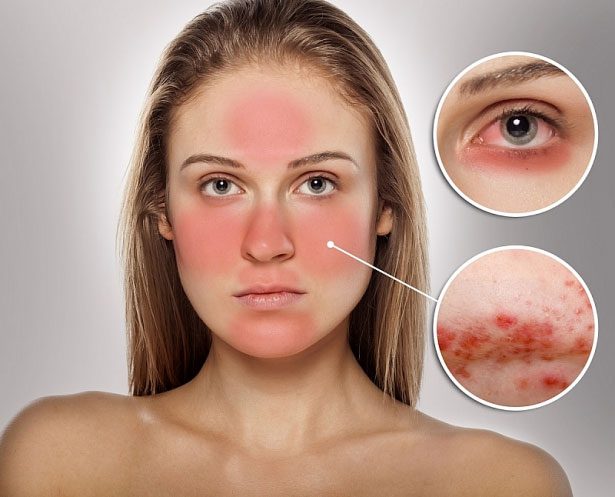When sweating in a polluted environment filled with dust, you are more likely to develop acne, heat rash, melasma, inflammation, or fungal infections.
Dr. Trinh Ngo Binh from the Dermatology Department at Vinmec Central Park International Hospital in Ho Chi Minh City summarizes 8 common skin diseases that often occur during the hot summer weather, along with prevention and treatment methods.
Heat Rash
Heat rash is a benign condition that usually does not require treatment.
- Signs: Numerous small itchy bumps on the head, neck, and shoulders. Heat rash can appear in various forms such as crystal, red, pustular, or deep heat rash.
- Management: In most cases, heat rash resolves on its own within a few days. For severe cases, apply calamine lotion or consult a dermatologist.
Acne
Acne is a chronic condition of the sebaceous glands and hair follicles, commonly seen during puberty and exacerbated in hot weather. Acne usually appears on the face, neck, shoulders, chest, and back.
- Signs: Closed comedones, open comedones, pustular papules, nodules, and cysts.
- Management: Keep the skin dry and avoid makeup that clogs pores. Do not pick at acne. Reduce stress and maintain a low-sugar, low-fat diet. Use medication as prescribed by a doctor depending on the severity of the acne.

Common skin diseases in summer that you should be aware of.
Foot Fungi
Foot fungus is caused by superficial fungal hyphae, typically occurring in warm, humid conditions such as in shoes, socks, swimming pools, locker rooms, and public bathroom floors. Diabetic individuals or those with compromised immune systems are also at risk for foot fungus.
- Signs: Red, scaly patches on the instep or sole of the foot accompanied by itching, with raised, blister-like borders, and often circular or arc-shaped. Inflammation and discharge may appear between the toes, causing intense itching.
- Management: Use topical or oral antifungal medications. Keep feet dry and avoid closed shoes. Sprinkle antifungal powder on feet and inside shoes daily. Wear flip-flops in swimming pools or public bathrooms.
Dermatophyte Infections
Dermatophyte infections, also known as ringworm, are caused by superficial fungal hyphae. Different body areas may have specific names like tinea corporis (body), tinea capitis (scalp), tinea pedis (foot), and tinea cruris (groin).
- Signs: Red, itchy patches with scaling, raised borders, and blister-like formations, often circular or arc-shaped. Intense itching is common.
- Management: Use topical or oral antifungal medications. Keep the body dry. Avoid sharing items or washing clothes with individuals infected with dermatophytes. Avoid tight-fitting clothing.
Intertrigo
Intertrigo is a chronic superficial infection of skin folds caused by the bacterium Corynebacterium minutissimum.
- Signs: Brown or pink patches with well-defined borders, thin scaling, superficial cracks, and mild to moderate itching. Common areas include the armpits, groin, between toes, under the breasts, and around the navel.
- Management: Use topical antibiotics. Keep skin folds dry.
Folliculitis
Folliculitis is an infection of the hair follicles usually caused by bacteria (Staphylococcus), fungi, or Demodex mites. Contributing factors include hot and humid climates, shaving, plucking, or waxing hair, diabetes, and immune suppression.
- Signs: Symptoms vary depending on the causative agent, typically presenting as pustular erythema on hair follicles, which later crusts and scales in hairy areas.
- Management: Use antibiotics, antifungals, or medications to target Demodex mites based on the underlying cause. Eliminate contributing factors.
Melasma
Melasma often occurs during pregnancy, while using contraceptive pills, or during menopause. Excessive exposure to sunlight can also cause melasma.
- Signs: Brown, tan, or grayish patches on the face, typically on both cheeks.
- Management: Avoid sun exposure. Use melasma treatment creams or laser therapy as directed by a doctor.
For healthy skin during the summer, Dr. Binh recommends washing your face thoroughly with water and facial cleanser several times a day. Apply sunscreen or cover up well when exposed to sunlight. Drink plenty of water and eat a lot of fruits and vegetables. Use moisturizer at night. Keep bedding and pillows clean. Those who sweat excessively should wear loose-fitting clothes made from moisture-wicking fabrics. If skin diseases become severe, consult a doctor for timely diagnosis and treatment.
Sunlight-Induced Skin Diseases
Some skin diseases are caused by or worsen with sun exposure. Photosensitive skin conditions such as systemic lupus erythematosus, subacute cutaneous lupus erythematosus, and discoid lupus erythematosus can worsen in summer. Porphyria cutanea tarda and pellagra also worsen in sunny weather. Conditions caused by excessive sun exposure, such as polymorphic light eruption, solar dermatitis, and actinic keratosis, typically worsen in summer, affecting areas of exposed skin.
Treatment for these conditions is complex, but the key principle is proactive sun avoidance, such as wearing wide-brimmed hats, masks, sunglasses, long-sleeved clothing, or using sunscreens with an SPF of 30 or higher. Additionally, depending on each disease’s mechanism, appropriate systemic medications may be necessary.
Sweat Gland Disorders
In hot summer weather, excessive sweating can lead to sweat gland inflammation, particularly in children, characterized by vesicles, tiny papules, and redness in areas with many sweat glands, such as the back, chest, forehead, and neck. Patients often experience significant itching, especially in hot, sweaty conditions.
Treatment for sweat gland inflammation may include topical solutions applied 2-3 times a day, antibacterial and mild corticosteroid creams such as Fucidin H applied once or twice daily, and bathing children with baby bath solutions like Lactacid or Cetaphil. Wearing cool, airy, breathable cotton clothing can help keep the skin dry and comfortable.
Sun Sensitivity

This is a skin condition that reacts to sunlight.
This skin condition often occurs in individuals with fair skin who are overly sensitive to sunlight. During sun exposure, skin on the arms and face may become red and even blistered.
Additionally, while freckles are not classified as a disease, they can worsen with excessive sun exposure. It’s essential to avoid prolonged sun exposure, supplement with vitamins B and C, and use sunscreen products.
Preventing Skin Diseases During Hot Days
Dr. Nguyen Thuy Linh, Deputy Head of the Dermatology Department for Women and Children, advises: “Everyone should also pay attention to moisturizing their skin while using air conditioning daily. Every 2-3 hours, if your skin feels tight or dry, you can reapply a layer of moisturizer or use a mineral spray to alleviate this and prevent temporary dehydration.”
Furthermore, individuals should follow basic skincare steps including cleansing with appropriate solutions, using toner or moisturizing serum, applying moisturizer to prevent water loss, and ultimately using sunscreen.
In time-constrained situations, sunscreen can be used immediately. It’s important to note that cleansing steps should be applied year-round, regardless of the season.
When indoors with air conditioning, individuals should drink enough water even if they do not feel thirsty, as water loss still occurs. Water is essential for metabolic activities and antioxidant protection of skin cells.
Dr. Linh recommends: “Everyone should drink at least 2 liters of water daily, taking small sips over 10-15 minutes. Avoid drinking large quantities at once, as this causes fluid to be filtered through the bladder too quickly, resulting in less absorption into cells and reduced moisturizing effectiveness.”
Final note: Ensure a balanced diet and daily lifestyle. Summer offers many fresh, sweet fruits, but they should be consumed in moderation.
The reason is that the skin ages faster when we consume too much sugar (which is abundant in fruits). It is advisable to prioritize fruits and vegetables rich in natural vitamins.


















































